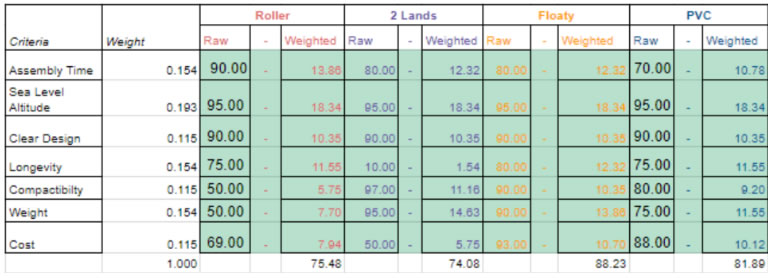Designs
Final Design:
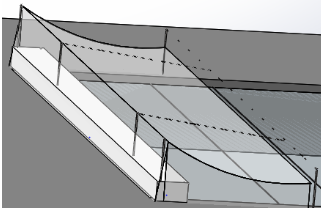
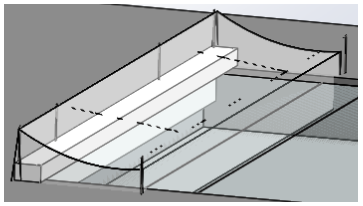
The final design used aspects of our top concepts to fulfill the customer needs and engineering requirements. The final built design used a 10-mil skrim vinyl plastic to form the enclosure. The material had to be cut and sewn to make a box shape with the dimensions of 77 ft long for the length of the pool, 17 ft wide covering one lane of the pool and the bulk head, which is a floating 75x4 ft. platform. The enclosure is roughly 8 ft tall so the coach can freely walk inside on the bulkhead to instruct the swimmer(s). The enclosure is roughly 4 ft. above the water where the swimmers will be. This was done to minimize the volume so the future oxygenating company can fill it with oxygen as fast as possible to mimic sea-level conditions.
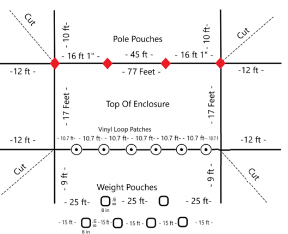
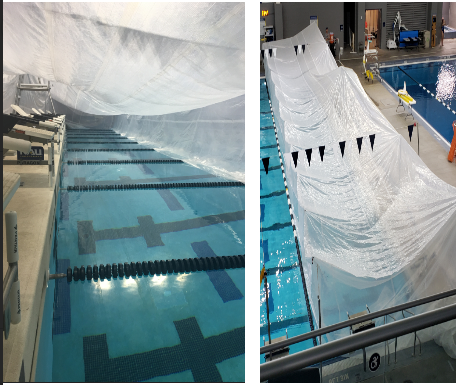
The enclosure is held up with 6 support beams, 4 spaced along the length of the bulk head, additionally 2 more supports beams will be used on both ends of the 1st lane across the pool. These supports will have 3 eye hooks in them at 6, 5, and 4 feet this will allow for a wire with a ratchet at one end to go through 6 vinyl loops, this enturn holds the entire structure up. A zipper was sewn for the coach to enter and exit from between two of the poles on the bulkhead.
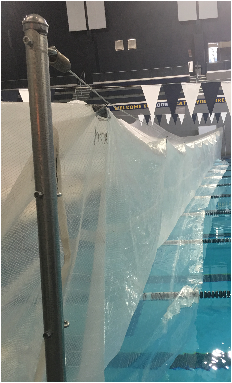
Top 4 Designs Concepts
Design 1: 2 Lands
The 2 lands design used the concept of storing the enclosure under the water on or near the bottom of the pool. This would eliminate the need for storage space except for the pump/pressurization system. When needed, air would be pumped into enclosure raising it from the bottom. After fully ascended the swimmer would be able to enter from underneath and train within the environment. After use the air could then be pumped out and the enclosure would naturally sink back to the bottom. Some pros of this idea were that storage space and weight of enclosure would not be a factor, also the cost would be minimal as just the enclosure material and pump are needed for this design. The cons of this concept are that have the enclosure stored near the bottom of the pool could be a safety concern. Also, with having the design stored in the water it would be constantly exposed to the chemicals in the water possibly causing it to deteriorate at a rapid rate.
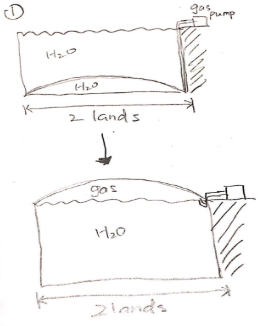
Design 2: Roller
The roller design is based loosely off a pool cover that is rolled onto a spindle at one end of the pool. This concept would dispense the enclosure out and then be inflated into a dome shape enclosure. When not in use this would of provided easy storage because the entire enclosure would be rolled up and would be moveable with wheels fixed on the frame holding the spindle. Pros of this concept was the weight would no longer be a factor because the design wouldn’t have to be picked up and storage space would be minimized. Cons of this would be an extremely long spindle holder would be needed and would be costly.
Design 3: Floaty
The design Floaty, uses a bubble themed structure with an inflatable pool toy like base. Attached to the base of the enclosure will be small weights that will be evenly spaced along the bottom of the air chambers base. The design would be aired up by a compressor, this should make for quick assembly times. Once the base is aired up the base is then laid across the lanes of the pool and attached to the sides of the hoods along the short wall of the pool. The air pumps provided by a 3rd party company would be attached to the corresponding attachment points, then the system will be turned on and the enclosure will be ready once the signal is given by the system. Some pros for this design were the quick assembly time and the ease of use. While some cons were the difficult collapsing methods including the complex folding of the enclosure to allow for increased longevity.
Design 4: PVC
This design used PVC as the main structure for the enclosure. The PVC would house a driven design layout for the frame structure. The assembly would include putting the large set-up pieces together to create a frame. The frame would include four set post that will be the main supporting area for the entire cover. The cover would be set across the top of the frame with weights along the edges of the cover which will create the seal between the air and water. Some pros for this concept included a much higher factor of safety for the users and ensures for a large work space for the coach to walk and help train athletes. The cons for this design included, assembly/disassembly will take much longer due to the many pieces that will comprise the frame. Also, the frame elements would increase the amount of space the design will take up in storage compared to some other designs.
Rationale for Design Selection
The decision matrix shown below, shows the top four designs, the design Floaty was the highest contender coming in a weighted total of 88.23. These results were found and calculated from the values determined on the Pugh chart giving the Floaty design a plus on the criteria of cost, weight, compatibility, longevity, and assembly time. The disadvantages for this design are mainly focused on the disassembly time because the enclosure would need to be folded up for storage.
